PEOPLE OF IDEAS

THE MIDDLE AGES
(450 to 1400 AD)
By Alphabetical
Order:
A
Abelard,
Peter
Albertus
"Magnus"
Alcuin
Al-Farabi
Anselm
Aquinas,
Thomas
Avicenna
ibn Sina
Averroës
ibn Rushd
B
Bacon,
Roger
Bede
Benedict
of Nursia
Berengar
Bernard
of Clairvaux
Boccaccio,
Giovanni
Boethius
Bonaventura
(Giovanni di Fidanza)
Boniface
C
Catherine
of Siena
Chaucer,
Geoffrey
Cloud
of Unknowing
Columba
Concordat
of Worms (1122)
The
Council of:
Constantinople
(553)
Constantinople
(680-681)
Nicea
(787)
Cydones,
Demetrius
Cyril
D
Dante
Alighieri
Dionysius
the Areopagite
Dominic
de Guzman
Duns
Scotus
E
F
Francis
(Giovanni
Bernardone)
Frederick
I Hohenstaufen
("Barbarossa")
Frederick
II Hohenstaufen
G
Giotto di
Bondone
Gregory
"The
Great" (Pope)
Gregory
VII (Pope)
"Hildebrand"
Groote,
Gerard
|
H
Hildegard
of Bingen
Hilton,
Walter
Hugh
of St. Victor
I
Iconoclast
Controversy
Innocent
III (Pope)
J
Joachim of
Fiore
John
of Damascus
John
of Salisbury
John Scotus
Erigena
Julian
of Norwich
Justinian
(Eastern
Emperor)
L
Leo I "The Great"
(Pope)
Leo IX
(Pope)
Lombard,
Peter
M
Maimonides
(Rabbi
Moses ben Maimon)
Marsilio
of Padua
Maximus
the Confessor
Mechtilde
of Magdeburg
Methodius
Muhammad
of Mecca
O
Ockham,
William
of
P
Petrarch,
Francesco
Proclus
Procopius
of Caesarea
Psellus,
Michael
R
Radewijns,
Florens
Rolle,
Richard
Ruysbroeck,
Jan
van
S
Siger of
Brabant
Suso,
Heinrich
T
Tauler,
Johannes
Theologia
Germanica
U
Urban II
(Pope)
W
Waldo,
Peter
William
of Ockham |
THE DWINDLING DAYS OF HELLENISTIC PHILOSOPHY (Early 400s to Early 500s AD) |
Proclus
Diadochus (c. 410-485)
 Proclus' major works or writings:
Proclus' major works or writings:
Commentary on
Euclid
Hypotyposis
Book of
Causes
Elements
Elements of
Physics
Platonic
Theology
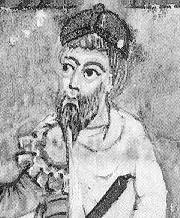
Boethius
(480-524)
 Boethius' major works or writings:
Boethius' major works or writings:
The
Consolation of Philosophy
The Trinity is One God, Not
Three Gods
|
|
CHRISTIAN LEARNING AMIDST THE GERMANIC DARKNESS (450 to 1050) |
Leo I
"the Great" (pope: 440-461)
In the Roman West, under Leo I, the
Roman bishops ("popes") became predominant. The other bishops, especially
the North African bishops, simply disappeared from view as the German hordes
collapsed their power bases. (In the East, the patriarchs in Constantinople,
Antioch and Alexandria vied with each other for the remaining
authority.)
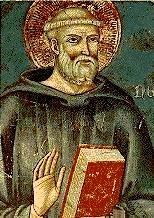
Benedict
of Nursia (480-547)
In the early 500s Benedict established
his Benedictine "Rule" within the monasteries under his supervision – which
proved successful and popular and widely copied among the abbeys. This
served to give order, power and wealth to the monastic movement. Indeed,
over time, these monasteries themselves grew very rich.
 Benedict's major works or writings:
Benedict's major works or writings:
The Rule of
Benedict
Columba
(521-597)
A monk and missionary, known also by
his Irish nickname, Columcille ("Dove of the church"). After his
banishment from Ireland for opposing the King he and 12 of his disciples
founded the missionary settlement at Iona (563) – which became the launch
site for bringing Scotland into the Christian faith.
He had also been very active in shaping
the Irish church in his earlier years, founding several hundred churches
and monasteries in Ireland as well. And even after establishing himself
in Iona he remained active in Irish affairs, helping to shape the governmental
structure of Ireland at the council of Druim Cetta in 575.
 Columba's major works or writings:
Columba's major works or writings:
The Rule of St.
Columba
Columban
(c. 540-615)
An Irish monk who in 591 (at age 50+)
traveled with 12 of his disciples to the European continent, to the Burgundian
kingdom (in Southeastern Gaul or present-day France) to establish monasteries
among the Celtic Gauls.
But his strong disapproval of the
lax moral and spiritual conditions within the Burgundian government and
Roman church in that region brought him under attack. In 610 (at
age 70!) he was forced out of Burgundy. He eventually settled in
Switzerland to preach the faith to the pagan Alemanni – though he was soon
chased from this region as well because of his having chopped down sacred
pagan trees and because of a continuing conspiracy against him in the courts
of Theodoric II. Thus he moved south into Italy (c. 612-614) and
established a monastery at Bobbio, where he died a short time later.
In his sermons, teachings, writings
and personal example, he left a legacy of spiritual integrity and vitality
which gave inspiration to Christians generations after him.
Gregory
I "the Great" (b. 540 pope: 590-604)
Gregory was chiefly responsible for
reorganizing the structure of the Western Church – giving it the broad
features that it would have for the rest of the Middle Ages – and indeed,
through the on-going Roman Catholic Church, even down to the present.
Gregory was born of a noble or "patrician"
Roman family – a family possessing not only great wealth but also a distinguished
placement in the Christian community as a family of deep Christian devotion.
As a youth Gregory received the typical patrician schooling at which he
proved to be highly accomplished. He eventually stepped into a public
career (as would have been expected of one with his family background)
and by his early 30s he had become the prefect of the city of Rome.
But soon thereafter his abandoned his public life and took up the vow of
poverty in becoming a monk. Eventually his family inheritance of
considerable landholding he turned to use as the site of a number of monasteries.
But Pope Pelagius II pressured him to come out of seclusion and first had
him appointed as a deacon of Rome and then as papal ambassador to the Eastern
Roman or Byzantine court in Constantinople. Here he revealed his
highly organized mind in a controversy he had with the Eastern Patriarch
– a controversy in which the Emperor eventually placed himself squarely
on Gregory's side of the argument. Eventually he was returned to
Rome and soon became abbot of St. Andrew's monastery – where he also became
a widely respected teacher of the Scriptures. But he became
fascinated with the the idea of becoming a missionary to the Anglo-Saxons
of Britain – but at the insistence of a very upset Roman populace was
recalled to Rome shortly after his departure. Under a promise never
to leave Rome, he soon became a special assistant to Pelagius II.
But he never lost his fascination for the idea of a mission to the Anglo-Saxons
of Britain.
In 590, during the middle of a horrible
plague which had followed upon equally devastating floods, Pelagius II
died – and the unanimous Roman choice for pope went to Gregory – who
nonetheless did what he could to duck the responsibility. Nonetheless
the Eastern Emperor confirmed the appointment and Gregory was forced to
take up the position as bishop of Rome (pope).
Soon after his accession to the papacy,
he began to demonstrate his brilliance as a church administrator (including
the management of the vast land holdings of the church, which he used generously
to support the poor) – and as a dominating authority throughout the whole
Christian world. With respect to church organization, the personal
behavior of priests and bishops, and the handling of church monies, he
was deeply demanding of papal discipline throughout the ranks of the church..
He even claimed authority over the Patriarch of Constantinople, insisting
that the church at Rome was the true Apostolic See.
He also drew the church into active
politics – particularly when it became evident that the Byzantine Emperor
was not going to do anything to stop the advancement of the Germanic Lombards
across Italy. Gregory not only appointed a new tribune to Naples
to organize that city's defenses against the Lombards but eventually entered
directly into negotiations with the Lombards for peace in Italy.
He finally had a chance to fulfill
an old dream of sending a mission to the Angles in Britain – sending Augustine
of Canterbury to begin the conversion of the Angles and Saxons in Britain.
He also worked closely with the monastic movement reformed by Benedict
– by drawing monasteries more closely into the ecclesiastical system that
he presided over and disciplining it according to his strict standards
... and at the same time acting as a protector of the monasteries against
the efforts of bishops to bring these monasteries under their own control.
 Gregory's major works or writings:
Gregory's major works or writings:
Moralia in
Job
Book of Pastoral
Care
Augustine
of Canterbury (? - c. 605)
Augustine was sent by Pope Gregory from
Rome (where he had been prior of a Benedictine abbey) to England to convert
the Anglo-Saxons to Catholic Christianity. Augustine arrived in Kent
in 597 accompanied by 40 monks. Kentish King Ethelbert was supportive
of Augustine's mission and gave him a place at Canterbury to base his
mission.
Augustine's mission proved to be
highly successful. Ethelbert and thousands of English were brought
to the faith in the first year alone. Within a few years a number
of other missionaries were sent to England to assist Augustine, including
12 bishops – over which Augustine presided as archbishop. His church
(Christ Church) was recognized as the cathedral for England
Aidan
(?-651)
Aidan was a humble Irish monk at Iona,
when he was consecrated in 635 as bishop and sent to evangelize the English
under King Oswald (and King Oswin who succeeded Oswald in 642) in Northumbria.
Just off the Northumbrian coast, Aidan established the mission center of
Landisfarne for the training of more missionaries to the English, including
the brothers Chad and Cedd (missionaries to the Mercians and East Saxons
respectively) and Hilda (founder of a number of monasteries, including
the notable monastery of Whitby).
Cuthbert
(634-687)
A profoundly spiritual and humble Celtic
monk who entered Melrose Abbey as a youth, became very close to its prior,
Boisil, and succeeded him in 661 after a plague killed Boisil. Cuthbert
quickly gained a reputation as a miracle worker after he went about the
countryside praying for and treating plague victims.
When after the decision of the Synod
of Whitby (664) to adopt Roman and drop Celtic church traditions (a decision
which Cuthbert supported) Colman, who had been a leader of the Celtic position,
resigned his post as prior of Lindisfarne. Cuthbert was invited to
take his place. As prior of Lindisfarne, Cuthbert supervised the
changeover from the more informal Celtic to the much more highly structured
Roman church style.
But Cuthbert had more a heart for
quiet piety than for administrative duties. In 676, searching for
solitude, he ventured to Farne Island and established himself in a hermit's
cell there. However his fame would not go away. He was recalled
briefly as prior of Lindisfarne and then once again retreated to Farne
Island where he lived out his days in prayer
So well loved was Cuthbert that the
beautiful Lindisfarne Gospel (a treasure today of the British Library!)
was published by Bishop Eadfrith of Lindisfarne in Cuthbert's honor shortly
after his death.
Synod
of Whitby (663-664)
The Christians convened at Whitby in
Northumbria to face the decision as to whether to follow Celtic or Roman
patterns of church organization and life. The decision (supported
by Cuthbert, among many other leaders) was made in favor of the Roman
formula.
Bede (the
"Venerable") (c. 673-735)
An English monk who wrote the history
of the English Church.
 Bede's major work or writing:
Bede's major work or writing:
The Ecclesiastical
History of the English People (731)
Conversion of
England
The Life of
Cuthbert
Boniface
(Winfrid) (ca. 680-754)
English missionary to
Germany
Alcuin
(735-804)
Charlemagne attracted Latin scholars
around him, notably Alcuin an English scholar.
John Scotus
Erigena (815-877)
 Erigena's major works or writings:
Erigena's major works or writings:
The
Division of Nature
|
|
THE ROMAN (BYZANTINE) EMPIRE LIVES ON IN THE EAST (450 to 635) |
Dionysius
the Areopagite
"Dionysius" was an anonymous Neo-Platonist
writer around 500 – posing as a first century author
 Dionysius' major works or writings:
Dionysius' major works or writings:
Divine
Names
Mystical
Theology
Heavenly
Hierarchy
Ecclesiastical
Hierarchy
Procopius
of Caesarea (ca. 500-560)
Procopius was the court chronicler of
the life of the Eastern Roman Emperor, Justinian. In his study
(Polemon/Wars)
of the military achievements of Justinian he was quite laudatory.
But in his study (Anecdota/Secret History) of Justinian's personal
life and that of his family, notably his wife, Theodora, he was sharply
critical.
 Procopius' major works or writings:
Procopius' major works or writings:
Polemon
(Wars)
Secret
History
The Emperor
Justinian (527-565)
The Second
Council of Constantinople (553)
The Fifth Ecumenical Council.
This Council was called to try to settle a dispute between: 1) the Antiochene
supporters of the Chalcedon formula, which emphasized the two natures (divine
and human) of Christ and 2) the Monophysite Alexandrians with Cyril's formula,
which stressed the oneness of Christ out of his two natures (the "hypostatic"
union).
A compromise formula was established
by emperor Justinian stressing the oneness of Christ (Alexandrian) in two
distinct natures (Antiochene).
As an additional part of the "house-cleaning"
agenda by Justinian (to bring theological unity and conformity to the Eastern
Roman or Byzantine Empire), the Council condemned or anathematized: 1)
the teachings of Origen and Evagrius; 2) the teachings of the dualist Nestorius
and his teacher, Theodore of Mapsuestia; and 3) some of the early anti-Cyrilline
works of Theodoret and Ibas.
 Documents
from the Second Council of Constantinople: Documents
from the Second Council of Constantinople:
The Fifth Ecumenical
Council: Constantinople II (553)
Maximus the Confessor
(ca. 580-662)
Maximus was chief secretary to the emperor – who
became a monk in 614, but who nonetheless continued to influence the empire
greatly with his teachings on the two wills of Christ (in conformity to
the two natures of Christ).
He was hotly opposed by the Alexandrian
school which stressed the singularity of Christ's will (monotheletism).
When the Alexandrian school briefly gained the upper hand in the East,
he fled to Carthage and Rome where he influenced Western thinking on this
issue.
But he was brought back to Constantinople
and tortured by the Alexandrian party for his views. Then he was sent into
exile – where he died. He was viewed by his supporters as a martyr or
"confessor." |
|
THE ARAB-MUSLIM EMPIRE TAKES OVER IN THE EAST (635 to 1100) |
Muhammad
of Mecca (570-632)
Received his call as a prophet in
610.
The hegira (622) or
flight
of Muhammad from Mecca to Medina – marking the beginning event or starting
date on the Muslim calender.
 Muhammad's major works or writings:
Muhammad's major works or writings:
Qur'an
THE BYZANTINE REMNANT IN THE EAST (635 to 1453) |
The Third
Council of Constantinople (680-681)
This Council decided in favor of Maximus'
viewpoint: two distinct wills of Christ, just as two distinct natures.
This decision had the support of
the Roman pope Agatho who wrote an influential treatise for the Council.
An earlier Roman pope, Honorius, was condemned for his Monophysite
views.
The Alexandrians were rebuffed by
the decision of this Council. But due to the Muslim conquest of Egypt,
their views no longer carried great weight!
The Iconoclast
Controversy
This religious uproar in Byzantine Christendom
broke out in 726 when Eastern Emperor Leo III (680-741), who had just managed
to fight off the Muslim army from the gates of Constantinople and retake
most of Asia minor, went on the offensive against religious icons.
This provoked riots throughout Leo's dominions in the process – and produced
the effective end of Byzantine rule in Italy.
John of
Damascus (ca. 675-749)
John had inherited from his Christian
father a high position in the caliph's government; but losing this position,
he became a monk near Jerusalem.
He became an outspoken critic of
the Emperor's iconoclastic policy, making a distinction between veneration
and worship, stating that veneration of icons was merely the focus on the
visible human nature of Christ – themselves, like the written Gospels, merely
testimonies to the divine Christ.
 John of Damascus's major works or writings:
John of Damascus's major works or writings:
The Fountain of Knowledge:
Dialectic; Heresies; Exact Exposition of the Orthodox
Faith
The
Second Council of Nicea (787)
The Seventh Ecumenical Council
 Documents
from the Second Council of Nicea: Documents
from the Second Council of Nicea:
The Second Council of
Nicea (787)
Cyril
(827-869)
Greek missionary to the Slavs (Moravians).
Supposed inventor of the Cyrillic alphabet used by the Slavs.
Methodius
(825-885)
Brother of Saint Cyril and also a Greek
missionary to the Slavs (Moravians).
Michael
(Constantine) Psellus (1018-1078)
Byzantine philosopher whose interest
in Platonism and its association with Christian theology helped to spark
a renewed interest in classical philosophy in the East. This would
eventually touch the same interest in the West – during the Renaissance
several centuries later.
Demetrius
Cydones (1324-1398)
Cydones was a Byzantine humanist scholar
who travelled to and lived in Italy, introducing the study of Greek
in Italy as that country was just undergoing the Renaissance interest in
classic scholarship.
In 1354 Cydones journeyed to Italy
to study the Latin classics – which he then translated into Greek.
He was so enamoured of Latin culture that remained in Italy until
1369 – converting from Greek Orthodoxy to Roman Catholicism while he was
there.
Upon his return to Constantinople
he was named Prime Minister by Byzantine Emperor John V Palaeologus.
But discouraged by the inability (including incompetency) of the Byzantines
to hold off Turkish growth, he retired from that position in 1383.
Then in 1390 he returned to Italy,
opening up an Academy that taught Greek scholarship to the Venetian and
Florentine students – encouraging the classic foundations of the new Renaissance
culture.
He was an active supporter of the
idea of the Eastern and Western churches reuniting – though he made no headway
with either groups.
In 1391 he was called back to Constantinople,
to become prime minister to the Greek Emperor, Manuel II Palaeologus – a
former student of his. But in 1396 he resigned from that office,
because many of the Byzantines found his earlier conversion to Catholicism
intolerable.
 Cydones' major works or writings:
Cydones' major works or writings:
De contemnenda morte
(On Despising Death)
Symbouleutikoi
(Exhortations)
|
|
ECCLESIASTICAL / IMPERIAL REVIVAL IN THE WEST (1050 to 1250) |
Leo IX
(b. 1002 pope: 1049-1054)
Reform of the papacy. Rupture
of relations with Eastern Orthodoxy (though not his desire; occurred at
time of his death)
Gregory
VII [Hildebrand] (pope: 1073-1085)
In 1076 Gregory excommunicated and brought
under papal discipline the Holy Roman Emperor. Encounter with emperor
Henry IV at Canossa (1077)
Dictatus
Papae
Urban
II (b. 1042 pope 1088-1099)
In 1095 he galvanized the faith of German/Norman
Europe as he preached the first (and only authentic) crusade against the
Muslims.
Concordat
of Worms (1122)
Compromise in the investiture controversy:
recognizing papal jurisdiction over ecclesiastical appointments (or investiture)
and imperial jurisdiction over temporal appointments.
Frederick
I Hohenstaufen (Barbarossa) (1152-1190)
Holy Roman Emperor
Innocent
III (b. 1160 pope: 1198-1216)
Frederick
II Hohenstaufen (1194-1250)
Holy Roman Emperor |
|
INTELLECTUAL STIRRINGS IN THE WEST (1050-1150) |
Berengar
(999-1088)
 Berengar's major works or writings:
Berengar's major works or writings:
De Sacra Coena adversus
Lanfrancum
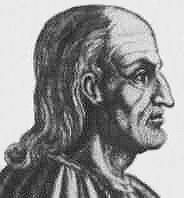
Anselm
(1033-1109)
Anselm was a theological writer of the
first order. He employed reason in the refinement of faith.
 Anselm's major works or writings:
Anselm's major works or writings:
Proslogion
Monol
ogium
Gaunilon's on behalf
of the fool
Cur
Deus Homo? (Why Did God Become Man?)
Hugh of St. Victor
(fl. early 1100s)
Augustinian monk in early 12th century
Paris. Though a Platonist and Christian mystic, he proposed the study
of the natural/secular world: the trivium (grammar, rhetoric,
dialectic or logic ); the quadrivium (arithmetic, music, geometry,
astronomy).
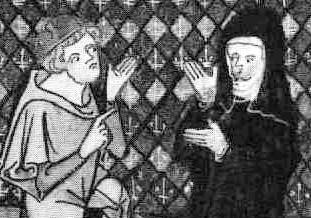
Peter
Abelard (1079-1142)
Abelard was given to an irreverent exploration
of the earthly life. He was a master logician and critical
of the thought processes of his times. But he ran into the determined
opposition of Bernard of Clairvaux and Peter Lombard who thoroughly disliked
his impiety.
 Abelard's major works or writings:
Abelard's major works or writings:
Story
of My Calamities
Sic
et Non (commentary on contradictory statements
issued officially by the Church) 1079
Abelard
and Heloise (letters written to friends)
Ethics
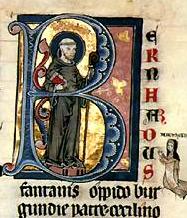
Bernard
of Clairvaux (1090-1153)
Cistercian. Bernard was a powerful
organizer of the monastic system. Under Bernard, the monastic movement
recovered its mystical or spiritual focus and its intellectual powers.
Some, like the Cistercians, sought the apostolic life of poverty, chastity
and obedience behind cloister walls; others, like the Augustinians, sought
the apostolic life in the form of service to the community – especially
evangelical teaching and preaching.
 Bernard's major works or writings:
Bernard's major works or writings:
On
Loving God
In Praise of the New
Knighthood
Hildegard of Bingen
(1098-1179)
An amazingly prolific writer, artist,
musician, poet, doctor and herbalist who was also the abbess of a dual
male/female monastery. Much of her work survives to this day.
The Rhineland mystics were strongly influenced by her works two centuries
later.
 Hildegard's major works or writings:
Hildegard's major works or writings:
Scivias (1141-1151)
an apocalyptic vision or prophecy relating the fate of mankind at the hands
of God
Liber vitae meritorum
(1158-1163)
Liber divinorum operum
(1163-1170) a musing over the cosmic character of light and life which
flows to and from God
Liber Simplicis
Medicinae
Liber Compositae
Medicinae
Musical
Compositions
Peter Lombard
(1100-1160)
Lombard put together a devotional guide,
Sentences,
which, after the Bible, was the most widely read writing of the Middle Ages.
 Lombard's major works or writings:
Lombard's major works or writings:
Four
Books of Sentences
John of Salisbury
(1120-1180)
Bishop of Chartres
 Salisbury's major works or writings:
Salisbury's major works or writings:
Metalogicon
Peter Waldo
(Valdes) ... and the Waldensians
Peter Waldo, or Valdes, a wealthy merchant
of Lyons, around 1175 gave up his wealth and took up the way of an itinerant
preacher of the gospel. He taught that only scripture should be the
ground of faith and anything that has no scriptural warrant should be rejected.
Though he gathered supporters he drew the opposition of the local bishop
for preaching (which was restricted to clergy); an appeal to Rome in 1179
resulted in refusal. For a time the Waldensians observed the restriction – but
then returned to evangelical preaching – resulting in their excommunication
in 1184 (along with the Cathars – with whom they had little in common).
Excommunication seemed only to draw
more support – principally in northern Italy and southern France as well
as along the French and German Rhine. They also had adherents in northern
Spain, in Bohemia and in Austria. |
|
THE NEW TEACHING ORDERS (Early 1200s) |
Dominic
de Guzman (1172-1221)
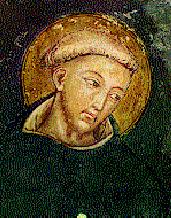 Spanish Augustinian; founder of the
Dominicans. In the early 1200s, the Spanish Augustinian canon, Dominic
urged the local monks in Southern France to fight Waldensianism and Catharism
by emulating the apostolic poverty of the heretics – thereby winning back
the support of the people. As the Albigensian crusade swirled around him
Dominic began to organize such a new evangelical teaching movement, finally
receiving papal recognition in 1217 as the Order of Preaching Brothers – though
the term "Dominican" became the popular designation of this new order. Spanish Augustinian; founder of the
Dominicans. In the early 1200s, the Spanish Augustinian canon, Dominic
urged the local monks in Southern France to fight Waldensianism and Catharism
by emulating the apostolic poverty of the heretics – thereby winning back
the support of the people. As the Albigensian crusade swirled around him
Dominic began to organize such a new evangelical teaching movement, finally
receiving papal recognition in 1217 as the Order of Preaching Brothers – though
the term "Dominican" became the popular designation of this new order.
This evangelical and service organization
spread rapidly throughout all Europe, reaching by 1230 from England and
Spain to Denmark, Poland, Greece and the Holy Land.
In short order also, the Dominicans
were given chief responsibility in administering the Inquisition (which
was in direct violation of Dominic's original understanding of their mission);
and they also sought and obtained professorships in the new universities,
becoming highly influential within the life of the institutional church.
Francis
(Giovanni Bernardone) (1181-1226)
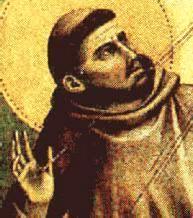
Of a different order of things was the
movement started by Giovanni Bernardone, known as the "Frenchman" or Francesco
(Francis). Francis had no ambition to do anything other than to try
to live his own life as he understood Christ would have; the fact that
others soon joined him was to him merely incidental. In fact, he
resisted as long as he could the creation of a formal "order," fearing
that the institutionalizing of his movement would destroy its original
spirit.
in 1206 or 1207 he had a vision calling
him to rebuild God's church – which he did with some of his father's money.
This got him in trouble with his father and local authorities, and he determined
to shed himself of all earthy connections to pursue this vision. He had
no plan, no long-range goal except to live and serve as Christ had done,
rebuilding churches and aiding the poor and sick.
He succeeded where Valdes failed – in
gaining papal support, though he came close himself to being declared one
of the heretics bothering the institutional church in those days. In 1215,
his movement was recognized as the Friars Minor (lesser brothers).
But the Franciscans became organized
effectively only with the help of cardinal Hugolino. Francis himself retreated
more and more from the responsibilities of leadership, having little heart
in seeing his movement institutionalized. When he died in 1226, he died
a very simple man.
But his movement, based on his charismatic
example, was spreading rapidly throughout Europe – in parallel with the
Dominicans.
The Dominican and Franciscan scholars
vied with each other for intellectual leadership of Europe, with the Franciscans
a bit more mystical (Platonic-Augustinian) and the Dominicans a bit more
naturalist (Aristotelian).

|
|
13th CENTURY MYSTICS (1200s) |
Joachim
of Fiore (1132-1202)
Allegorized human history into three
periods: the Father (patriarchal times of the Old Testament), the Son (the
priestly or clerical times of the New Testament the church), and the Holy
Spirit (a new age of individualistic spiritualism about to burst forth
fully into human history)
 Joachim of Fiore's major works or writings:
Joachim of Fiore's major works or writings:
Harmony of the Old
and New Testaments
Exposition of the Book of
Revelation
Psalterium of Ten
Strings
Everlasting
Gospel
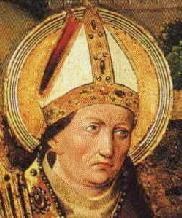 Bonaventure
(Giovanni di Fidanza) (1217-1274) Bonaventure
(Giovanni di Fidanza) (1217-1274)
Bonaventure was a Franciscan leader
of an Augustinian bent. He was a spiritualist and a mystic:
claiming that true knowledge came through meditation and prayer – aided
by divine grace – which raises our gaze above the mundane to the divine
where the soul reaches God and finds ecstatic peace and love.
Bonaventure was staunchly opposed
to the wealth and worldly ways of formal Christianity – seeing the example
of Christ and Francis as the true way of the Christian.
He was fervently opposed to the rationalism
of the Aristotelians at Paris (Aquinas)
 Bonaventure's major works or writings:
Bonaventure's major works or writings:
Journey into the Soul
of God (1259)
Disputed Questions Concerning
Christ's Knowledge
Life of St.
Francis(1263)
On the
Incarnation
Mechtilde
of Magdeburg (1210-1280)
A German Beguine (non-ordained lay worker)
from her youth, who late in life became a Dominican nun.
She received visions of God's love
which she carefully recorded – in a poetic beauty that influenced Christian
mysticism for centuries.
She also strove to reform the corruption
within church – which often forced her to move from town to town.
 Mechtilde's major works or writings:
Mechtilde's major works or writings:
The Flowing Light
of the Godhead (A
journal which she kept about her reflections on events in her
life)
|
|
THE GREAT AGE OF SCHOLASTICISM (1100 to 1300) |
Al-Farabi
(875-950)

ibn
Sina (Avicenna) (980-1037)
Persian Muslim: physician and
philosopher.
A source of recovery of Aristotle's
works previously lost to the Christian West.
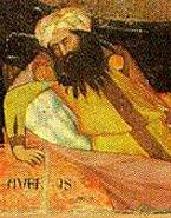
ibn
Rushd (Averroës) (1126-1198)
Averroës
was a Spanish Muslim who proved very influential in bringing Aristotle
to the West. This intellectual import owed nothing to Christianity
but relied purely on secular reason. In consequence Christian
learning among scholars that were strongly influenced by the power of Averroës'
thinking
moved away from Platonic-Augustinian theory and into "natural" theory.
Rabbi
Moses ben Maimon (Maimonides) (1135-1204)
Maimonides was a Jewish philosopher
born in Spain and educated in medicine and Aristotelian philosophy by Arab
instructors. He went to Egypt and became Saladin's physician.
He tried to unite the religions of
his times with ancient Greek philosophy.
Guide of the
Perplexed(1190)
Commentaries
"Kitáb
al Siraj"
"Mishneh
Torah"
Essays:
"On the Unity of
God"
"On Happiness"
"On the Terminology of
Logic"
"On
Resurrection"
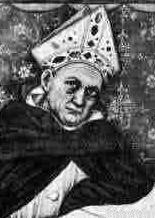
Albertus
Magnus (ca. 1200-1280)
A German-born Dominican professor in
Cologne (briefly also in Hildesheim, Freiburg, Ratisbon, Strasbourg and
Paris) as well as Bishop of Ratisbon. A voluminous writer on such
subjects as theology, ethics, logic, metaphysics, the human and "natural"
sciences. A true Doctor of the church – thus his title "magnus" ("the
great"). He was also most notably Aquinas' teacher.
Albertus stressed the importance
of the study of secular, even pagan, empirical science (Aristotle) along
with Christian theology. Indeed, Albertus felt that ultimately there
is only
one integral Truth, and that therefore theology should not
fear philosophy/science – but should work hand-in-hand with it to uncover
or reveal the full glory of God in creation.
 Albertus' major works or writings:
Albertus' major works or writings:
Opera Omnia
(complete works) (1890-99: thirty-eight quarto
volumes)
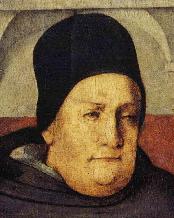 Thomas
Aquinas (1224-1274) Thomas
Aquinas (1224-1274)
The most famous of the Dominicans was
Thomas Aquinas, who taught in Paris and in Italy. Being Aristotelian
rather than Platonic-Augustinian, Aquinas felt that knowledge came principally
through the rational ordering of what our senses reveal to us about the
natural order.
The mysteries of God are known of
course through "revelation" – though for Aquinas that meant only the logical
revelation of Scripture and the Church in its various traditional teachings.
Aquinas opposed Platonic-Augustinian mysticism (Bonaventura) with its emphasis
upon truth derived from Spirit-inspired insight (until he had a mystical
experience of his own shortly before his death – and seemed to recant his
earlier views!).
Aquinas downplayed the role of the
Holy Spirit and replaced it with the power of the Church and its wide range
of sacraments in dispensing God's grace. Further he explained works
(of love) as the means by which faith is formed and the individual is justified
before God and thus saved – although these works are possible only through
the enabling power of God's Church-dispensed grace (through the
sacraments).
He was deeply influenced by Aristotle's
empiricism (taught by Albertus Magnus). He attempted to couple it
with the Platonic foundations of Christian philosophy of his times.
He attested to the primacy of revelation knowledge (found largely in scripture – interpreted
by the Church fathers) which alone gives us understanding of the higher
mysteries of faith.
However, he followed Albertus in
stressing the importance of empirical knowledge as well (though supposedly
a less lofty knowledge than revelation knowledge). The physical and
spiritual, body and soul, are not independent phenomenon but of one substance
(in distinction to the neo-Platonists/Augustinians) – though the soul alone
survives death (to be reunited with the body at the Last Day).
Physical sense perceptions striking
a human mind – essentially a blank slate at birth – bring us to the awareness
of reality (physical reality) as fact or data. The active intellect
(nous) focuses on this data and organizes it into useful information
or ideas or truths. The source of the organizational power of the mind
comes as a gift of God, who has placed an element of His own divine light
within us – so that we might recognize forms or ideas.
God's essence is in the way all existence
is summed up in Him – not just particular Ideas or Forms (as an architect's
blueprint of creation). God is existence – not just a part
of it. God is the very force giving rise to all life or existence
within creation (working according to Ideas or Forms to be sure – but transcending
the function of being merely a prototype of all things): drawing things
from potentiality to actuality.
It is God Himself who draws us ever-forward
in our thoughts, helping us to realize our humanity, in order to approach
fulfillment of His Divine Plan. But – God does not impart knowledge
by impressing every human thought with His thought (Platonism), but by
fully endowing man at birth with his own potential, through his own human
reason, to come to the knowledge of all things.
Indeed, its is God's design that
man's purpose in life is to come to know fully all things – as the sum of
all things gives testimony to the essence of God. By expanding his
own mind, man is making an intellectual journey toward God, is being conformed
to God, is participating in God – a matter of great pleasure for God. (empirical
knowledge as the way of mystical union with God).

 Aquinas' major works or writings:
Aquinas' major works or writings:
Manual against the
Heathens (early 1260s)
On Being and
Essence
On Truth
Summa
Theologica
Compendium of
Theology
Of God and His Creatures (Summa
Contra Gentiles)
On the Principles of
Nature
Catena Aurea (Patristic Commentary
on the Gospels)
The Catechetical Instructions
of St. Thomas Aquinas
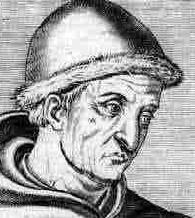
Roger
Bacon (1214-1294)
Bacon, a Franciscan, was a leading member
of a new, rising group of "natural scientists." He devoted himself
notably to the study of astronomy, chemistry and, especially, physics.
He was also a mathematician, logician and (implicitly) a theologian.
He emphasized (a la Aristotle) the
importance of observation in arriving at an understanding of things – contributing
to the development of the mindset that would eventually produce modern
science.
Siger
of Brabant (ca. 1240-1284)
Siger was a
secular Averroist
who pursued a course of human reason which claimed no need for divine revelation
to arrive at its truths.
Indeed, Siger seriously challenged
Aquinas' (and Albertus') idea of the interdependence of science and theology.
He claimed instead a "double-truth" universe of theology and natural science.
He noted that these two approaches to knowledge are quite capable of being
contradictory
in the truths that they arrive at.
In the face of such contradictions,
he chose the study of physical science for its own sake – ordered by its
own rules of logic – quite unrelated to theology.
Marsilio
of Padua (1290-1343)
|
|
ANTI-SCHOLASTIC SKEPTICISM
(Around 1300) |
Duns Scotus
(1265-1308)
Each thing in the universe had a distinctness
about its own existence. This was the foundation of reality: the world
is made up of a multitude of separate things which have their existence
quite independently of the existence of their defining "forms."
It is this separateness between particular
things and common forms that calls forth human thought – forcing the human
mind to make the connection between form and particulars. This exertion
of the human mind, however, is what gives dignity to human life and is
reflective of God's own determining influence on nature.
God, in all his sovereignty, is not
limited to the rules of human reason in the way he operates. God is not
under any restraint to work within the logic of "forms" or "universals" – but
can create anything as he particularly sees fit. Plato's (and Aristotle's)
"universals" are not compelling as the starting point of knowledge.
Further, there is no way that we
can use science or the study of the physical world to reflect back to the
nature of God. The physical world we see around us is the product
of free choice of God – who is able to make this world any way he wants
to. His choices reveal no necessary qualities about God.
 Scotus' major works or writings:
Scotus' major works or writings:
A Treatise on God
as First Principle
William
of Ockham (1285-1349)
English Franciscan in Paris.
Ockham was an ardent nominalist,
claiming that what was truly "real," that is, open to human understanding
through direct observation and reason, were the individual or particular
things belonging to the physical world. However, the mind naturally
reached beyond this reality to create broad mental categories or universals
(names for things, thus "nominalism") of closely related particulars (such
as "dog" – a broad category of all animals that we recognize individually
as dogs), abstracting from the particular to the universals (Plato's
"forms").
But these abstractions or universals
had no reality in themselves. "Universals" were only mental constructs,
nothing more – useful, of course, in helping us come to some kind of appreciation
of
reality, though by no means 100% reliable as a tool for establishing the
truth of things.
From this observation resulted "Ockham's
Razor": we must be very careful not to become too abstract in our
rational handling of particulars – lest we leave reality behind in the process.
Ockham was thus a skeptic with respect to the claims made for human reason
(anticipating David Hume by centuries).
With respect to religion, Ockham
(like Scotus) pointed out that we cannot move in our reasoning from our
observations about the particular aspects of creation to produce general
conclusions about the Creator. God is not constrained to work according
to the rules of human logic. Logic, in fact, can tell us nothing
about the nature of God or of ultimate things in creation. God can
be known only by faith – a quite different enterprise than using logic.
Only faith, not human logic, can touch God's absolute sovereignty and
freedom.
Ockham, in an effort to rescue faith
from Scholastic rationalism, acted to sever the relationship between religion
and secular science, a unity which Aquinas had worked carefully to develop.
To Ockham, reason was a useful tool for observing the natural world. But
it was useless in probing the realm of God. Only Divine revelation, received
through human faith, would bring us knowledge of that higher realm.
Ockham's nominalism had the effect of freeing secular science from theology.
Science no longer had to serve as the handmaiden of theology – or be justified
by its theological value.
 Ockham's major works or writings:
Ockham's major works or writings:
Dialogus
|
|
HUMANIST POETS, ARTISTS, AND MYSTICS OF THE EARLY 1300s |
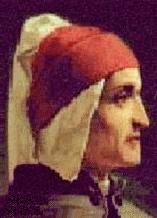 Dante
Alighieri (1265-1321) Dante
Alighieri (1265-1321)
Dante allegorized the physical world
that was coming to be a matter of great fascination to his times.
He ranged all reality from the divine
heavens to the evil infernal center of the earth – with human life on earth
somewhere between the two extremes.
This intense merging of Aristotelian
physical science (in particular astronomy) with Christian theology would
have later have dire consequences: a certain flexibility in attitude of
the church toward science would be lost. In the face of continuing
scientific discovery, the church would feel compelled to go to the defense
of a an older worldview – eventually giving the church the appearance of
being hopelessly backward in its thinking.
 Dante's major works or writings:
Dante's major works or writings:
Vita nuova (The New
Life) (1292)
De vulgari eloquentia (The
Eloquence of the Vernacular) (1304-1307)
Divina comedia (Divine
Comedy)
(1307-1321)
Inferno
(1316)
Purgatorio
(1319)
Paradiso
(1321)
Il convivio
(1307)
De monarchia
(1313)
Rima
Il fiore
Quaestio de aqua et de terra
(1320)
Giotto
di Bondone (1267-1337)
Muralist, fresco artist famed for his
life-like
depictions of Biblical personages – the mark of one who studied the human
make-up very closely.
 To see his murals on the Life of Saint Francis and of Jesus Christ To see his murals on the Life of Saint Francis and of Jesus Christ
Meister
Johannes Eckhart (1260-1327)
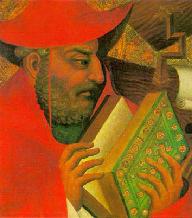
Born at Hochheim in Thuringia (Germany).
He joined the Dominican order when 15 and became a prominent member of
that order – studying, teaching and preaching in Paris, Strassburg and Cologne.
He eventually also became a leader of the "Rhineland mystics"
Eckhart viewed the human soul as
containing a "divine spark" and thus being truly of the nature of God's.
To Eckhart, the human soul was not just a mere reflection of God's soul,
created in his image. The spark of the human soul contained in its very
"ground" the same elements as God's soul – having existed at a point before
creation in complete unity with the soul of God.
Eckhart urged the faithful to retreat
from the world to search for this divine spark in the ground of their own
souls, to discover there the nascent Word of God, and to become mystically
reunited, not just with God but with "Godness" itself: to become
one with Divinity once again.
In his later life, he came under
suspicion of heresy as a neo-platonist or even pantheist. Eckhart
admitted to having been guilty of "exaggeration" and in the last years
of his life backed into a more orthodox Thomist position. Nonetheless
in 1329, shortly after his death, parts of his writings were condemned
by Pope John XXII.
 Eckhart's major works or writings:
Eckhart's major works or writings:
Opus Tripartitum
(only fragments survive: mostly the prologues to the three works)
Opus
propositionum
Opus
quæstionum
Opus
expositionum
Johannes
Tauler (1300-1361)
A German Dominican and disciple of Eckhart,
preaching and teaching in Strasbourg and Basel. Tauler taught a more orthodox
view that God gifts his people with a spiritual "ground" crafted in his
own divine image. This is conferred as a matter of divine grace; it is
not (as per Eckhart) "self- discovered" as a matter of natural property
of the human being. To Tauler, the return to "oneness" with God is a matter
of having our human wills united with God's – not a matter of absorbing
our human nature into God's divine nature.
Tauler's example and sermons (the
only surviving part of his writings) had a great influence on the Rhineland
school of mystics, and after them on Luther, because of his stress on suffering
and self-denial (experienced poignantly during the Black Death) and on
the reliance on grace as the center-pieces of Christian faith.
 Tauler's major works or writings:
Tauler's major works or writings:
The Inner Way
(36 Sermons)
Heinrich
Suso (1295-1360)
A Dominican who studied at Cologne and
was greatly influenced by Eckhart (whom he defended after the 1329 condemnation);
he preached in his native Constance and at Ulm. Like Tauler, he spoke of
the human union of wills – rather than substance – with God, and insisted
on the great and eternal difference between created and uncreated being.
 Suso's major works or writings:
Suso's major works or writings:
The Little Book of
Truth (a widely popular meditation on Christ's
passion)
Jan van
Ruysbroeck (1293-1381)
Flemish priest in Brussels; retired
to Groenendael where in 1349 he and friends established a contemplative
community of Augustinian canons.
 van Ruysbroeck's major works or writings:
van Ruysbroeck's major works or writings:
Spiritual
Expousals
an early work which drew the criticism from Jean de Gerson of being
pantheistic
Adornment
Supreme
Truth
Sparkling Stone -
a later work in which he stresses the continuing "created" nature of the
mystic, even in union with God. Also: such joyous union is designed to
lead to greater inspiration for the "common life" of good works, not retreat
from the common life.
Richard
Rolle (1300?-1349)
English hermit – who however ended life
as a spiritual director of Cistercian nuns at Hampole.
 Rolle's major works or writings:
Rolle's major works or writings:
De incendio amoris
(The Fire of Love)
De emendatione vitae (The
Mending of Life)
Contemplations of the Fear
and Love of God
Remedy against
Temptations
The Prick of
Conscience
"Thy Joy be in the Love of
Jesus"
Walter
Hilton (?-1396)
English hermit – who eventually became
an Augustinian canon.
 Hilton's major works or writings:
Hilton's major works or writings:
The Scale (or Ladder)
of Perfection
Treatise Written to a Devout
Man
The Song of
Angels
(Author
Unknown) The Cloud of Unknowing
A very influential English mystical
writing of the 1300s written after the style of the 6th century Dionysus
the Areopagite. It was once speculated that Walter Hilton wrote the
work, though scholars now believe this highly unlikely.
 The work itself:
The work itself:
The Cloud of
Unknowing
(Author
Unknown) Theologia Germanica
A very influential German mystical writing
of the 1300s. It was discovered and published in 1516 by Martin Luther,
who declared this work to be next to Scripture and the writings of Augustine
the most influential writing in his own spiritual formation.
 The work itself:
The work itself:
Theologia
Germanica
|
THE CLOSE OF THE MIDDLE AGES
(1350 to 1400) |
|
In the mid 1300s the Black Death
struck Europe – wiping out 25 million people. In England, in a 3-year period
it wiped out half of the population of 4 million people. After this a wave
of other epidemics swept a much weakened Europe.
In England, efforts by landowners
(including the church) to hold scarce labor captive, produced a massive
uprising in East-Central England known as the Peasants' Revolt (1351) – which
though suppressed, left among the commoners a legacy of discontent with
the wealth of the landowners and the church.
But the European spirit amazingly
revived quickly. However, this spirit tended toward a more humanistic
autonomy or self-sufficiency. Not that God was distrusted – but that the
human spirit itself seemed so powerful in the face of adversity.
The spirit of the renaissance was
being crafted in/through this new mood.
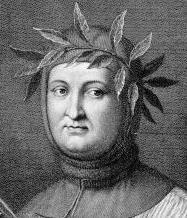
Francesco
Petrarch (1304-1374)
 Petrarch's major works or writings:
Petrarch's major works or writings:
Triumphs
(1351-1374).
On the
Solitary Life (1346)
Rime
(1374)
Canzone
(Sonnets)
Petrarch's
Secret
Familiar
Letters
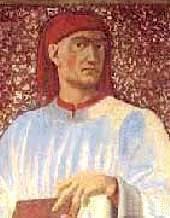
Giovanni
Boccaccio (1313-1375)
 Boccaccio's major works or writings:
Boccaccio's major works or writings:
The Decameron
(1350)

Geoffrey
Chaucer (1343-1400)
 Chaucer's major works or writings:
Chaucer's major works or writings:
Canterbury
Tales
Catherine
of Siena (1347-1380)
Dominican tertiary. A strong proponent
of the Pope's return to Rome from Avignon. Her theology combined the personal
elements of mystical rapture with an active Christian mission to the sick
and the poor.
 Catherine of Siena's major works or writings
Catherine of Siena's major works or writings
The Dialogue of the
Seraphic Virgin
Gerard
Groote (1340-1384)
Founder (1370s-1380s) in the eastern
Netherlands (centering in Deventer) of what eventually became known as
the "Modern Devotion" movement (Devotio moderna). Strongly influenced
by the Rhineland mystics and his friend, van Ruysbroek.
He took ordination as a deacon, and
lived within both monastic and parish worlds, actively serving as a spiritual
and practical reformer (which got him in trouble in 1383). He established
in his own home in Deventer a community of laywomen devoted to serving
God and society: the Sisters of the Common Life.
Florentius
(Florens) Radewijns (1350-1400)
A parish priest and disciple of Groote's
who established in Deventer the Brothers of the Common Life. These laymen
lived on the income of their book copying, permitting them to also teach
young men of humbler circumstances who demonstrated a potential for full-time
religious life.
Eventually these lay communities
moved closer to the monastic traditions, some even taking the rule of St.
Augustine and becoming fully encloistered.
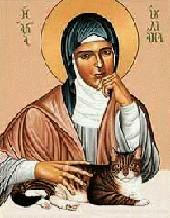
Julian
of Norwich (1342-1415)
Anchoress attached to St. Julian's Church.
Wrote of the Motherhood of God and Christ; stressed the goodness of God
and creation (despite the ravages of the Black Death).
 Julian of Norwich's major works or writings:
Julian of Norwich's major works or writings:
The Sixteen Revelations
of Divine Love
Revelations (in Middle
English)
|
THE MIDDLE AGES: A FULL HISTORY |
 Miles
H. Hodges Miles
H. Hodges
| | |











 Bonaventure
(Giovanni di Fidanza) (1217-1274)
Bonaventure
(Giovanni di Fidanza) (1217-1274)


 Thomas
Aquinas (1224-1274)
Thomas
Aquinas (1224-1274)








